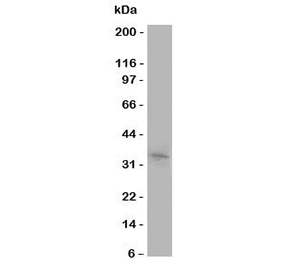- Tel: 858.663.9055
 Email: info@nsjbio.com
Email: info@nsjbio.com
- Tel: 858.663.9055
- Email: info@nsjbio.com
AQP10 Antibody reagents target aquaporin 10, an aquaglyceroporin channel expressed prominently in the small intestine. Unlike strictly water-selective aquaporins, AQP10 facilitates the transport of both water and small solutes, including glycerol and urea. This dual capacity places AQP10 at the interface of hydration, nutrient absorption, and energy metabolism.
AQP10 is localized to the brush-border membranes of enterocytes, where it contributes to intestinal permeability and fluid exchange. Beyond the gut, AQP10 is expressed in liver, adipose tissue, pancreas, and reproductive organs, reflecting additional roles in metabolism and physiology. Dysregulation of AQP10 expression has been linked to malabsorption syndromes, obesity, and metabolic disorders, as well as alterations in intestinal barrier function. For these reasons, the AQP10 Antibody is a vital tool for gut biology, nutrition science, and translational medicine. The Aquaporin 10 Antibody expands these applications by offering compatibility across diverse assays.
NSJ Bioreagents provides AQP10 Antibodies validated for immunohistochemistry, western blotting, immunofluorescence, flow cytometry, and ELISA. Each AQP10 Antibody undergoes rigorous validation to ensure specificity, reproducibility, and robust performance.
By choosing AQP10 Antibodies from NSJ Bioreagents, researchers gain reagents optimized for clarity and consistency. Our antibodies deliver strong detection in intestinal and metabolic tissues, reproducible signals in lysates, and dependable performance across translational pipelines. Detailed datasheets, recommended controls, and optimized protocols ensure reproducibility across both discovery and clinical research.
The AQP10 Antibody supports broad applications in gastrointestinal biology, metabolism, and translational research.
AQP10 Antibodies detect enterocyte expression in small intestine brush borders.
The AQP10 Antibody supports studies of gut barrier integrity and permeability.
Aquaporin 10 Antibody reagents validate biomarkers for malabsorption syndromes.
AQP10 Antibodies highlight roles in glycerol and solute transport during digestion.
The AQP10 Antibody supports studies of nutrient uptake and energy supply.
Aquaporin 10 Antibody reagents extend applications into nutrition science.
AQP10 Antibodies clarify links between intestinal transport and systemic energy balance.
The AQP10 Antibody supports research into obesity and insulin resistance.
Aquaporin 10 Antibody reagents provide translational biomarkers for metabolic health.
AQP10 Antibodies reveal expression in pancreas and liver.
The AQP10 Antibody supports studies of glucose metabolism and energy regulation.
Aquaporin 10 Antibody reagents extend into hepatology and diabetes research.
AQP10 Antibodies detect expression in testis and embryonic tissues.
The AQP10 Antibody supports fertility and developmental physiology studies.
Aquaporin 10 Antibody reagents clarify aquaglyceroporin diversity across tissues.
AQP10 Antibodies are integrated into biomarker-driven gastrointestinal and metabolic studies.
The AQP10 Antibody supports diagnostics for gut permeability and metabolic disorders.
Aquaporin 10 Antibody reagents ensure reproducibility in clinical pipelines.
AQP10 is a bridge between hydration and metabolism, linking intestinal absorption to systemic energy balance. The AQP10 Antibody equips researchers with validated tools to study gut permeability, nutrient absorption, and metabolic health, while the Aquaporin 10 Antibody expands applications into translational medicine.
In gastrointestinal research, AQP10 Antibodies clarify mechanisms of barrier function and solute uptake. In nutrition science, the AQP10 Antibody supports studies of malabsorption and energy metabolism. In metabolism, Aquaporin 10 Antibody reagents validate biomarkers for obesity and insulin resistance.
Clinically, AQP10 is being explored as a biomarker for intestinal dysfunction and obesity-related metabolic disorders. Reliable AQP10 Antibodies ensure reproducibility and accuracy, linking basic gut biology to diagnostics and therapeutic innovation.
AQP10 is a versatile aquaglyceroporin central to intestinal physiology and systemic metabolism. The AQP10 Antibody provides validated reagents for studying gut permeability, nutrient absorption, and metabolic regulation, while the Aquaporin 10 Antibody extends these applications into diagnostics and translational pipelines. By ensuring specificity, reproducibility, and assay versatility, these antibodies remain indispensable for advancing gut biology, metabolism, and clinical nutrition research.

Western blot testing of Aquaporin 10 / AQP10 antibody (cat # R31207) and human COLO320 cell lysate.